Trip Report
Text and some of the photographs by Clinton Smoke
In June, I had an opportunity to join about 100 other members of the Norfolk and Western Historical Society for their 19th annual gathering. This year we met at Marion, Ohio.Background. To many tourists, Marion is best known as the hometown and burial location of President Warren G. Harding and First Lady Florence Harding. But we should note that Marion was one of Ohio's major industrial centers until the 1970s. Marion Power Shovel was a Marion, Ohio based manufacturer of earth moving shovels and draglines, mainly used in construction and resource extraction.
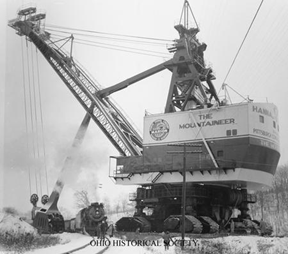 The company's main product line consisted of bucket mining shovels and dragline mining shovels.
From 1900 to the 1960s, Marion-built shovels and other products were among the best known trade
names in earth moving equipment. Products of the Marion Steam Shovel Company (later Marion Power
Shovel) built the Panama Canal. In the 1960s, NASA contracted with Power Shovel to construct the
crawler-transporters that moved the assembled Saturn V rockets, used by Project Apollo, to the launch pad.
The company's main product line consisted of bucket mining shovels and dragline mining shovels.
From 1900 to the 1960s, Marion-built shovels and other products were among the best known trade
names in earth moving equipment. Products of the Marion Steam Shovel Company (later Marion Power
Shovel) built the Panama Canal. In the 1960s, NASA contracted with Power Shovel to construct the
crawler-transporters that moved the assembled Saturn V rockets, used by Project Apollo, to the launch pad.
Marion built its first walking dragline in 1939 and became a key player in providing giant stripping shovels to the coal industry, being the first to put a long-boom revolving stripping shovel to work in North America in 1911. Marionís succession of giant shovels, many breaking world size records, culminated in the worldís largest in 1965, the Marion 6360. The 6360 at the Captain Mine, Ill., operated with a 180 cubic yard dipper. With an estimated weight of 15,000 tons, it holds the record as the heaviest mobile land machine.
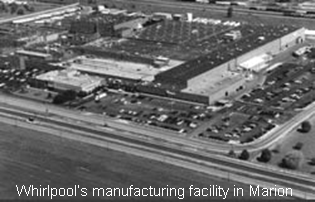 All of that is gone now. However, Marion remains a surprisingly viable community of about 35,000. It
is the nation's leader in corn and popcorn produced foods. Whirlpool Corp. is the largest employer in
the city operating the largest clothes-dryer manufacturing facility in the world.
All of that is gone now. However, Marion remains a surprisingly viable community of about 35,000. It
is the nation's leader in corn and popcorn produced foods. Whirlpool Corp. is the largest employer in
the city operating the largest clothes-dryer manufacturing facility in the world.
The city is also a rail center for CSX, and Norfolk Southern, linking all four points on the compass. To understand the strategic significance of Marion, we have to go back and look at the history of both railroads. Today, CSX represents the former NYC, Erie Lackawanna, and Hocking Valley Lines. NS represents the former Pennsylvania RR. All went through Marion. Today, NS and CSX transverse Ohio and converge at Marion and other places. There are two four-diamond crossings at Marion, about 200 feet apart, with the AC tower (shown on page 7 of last monthís issue of The Semaphore) located in between.
On Friday our little group boarded a bus for a one hour ride to Bellevue, Ohio, near Sandusky. At one time, five railroads served Bellevue. Today, NS operates a terminal at Bellevue, a facility that include a switching yard, engine repair shop, a car repair shop, and a transportation department (sales and administrative functions to support freight operations). Over 400 people work at Bellevue including Bellevue-based road crews and contract employees.
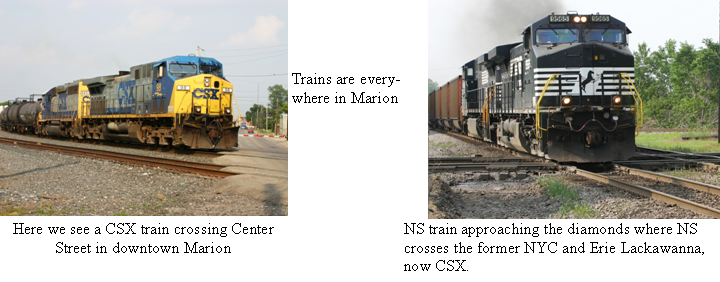
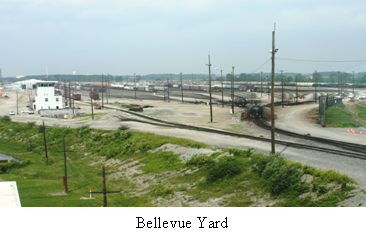 The yard, while by no means large by NS standards, is none-the-less impressive. There are 10 receiving tracks,
40 classification tracks, seven departure tracks, and 15 tracks for sorting and storing cars for and from local
destinations. The overall length of the yard is 6.5 miles. The operation of the hump yard is controlled by a
computer. While it is still necessary to manually pull the pin to uncouple a car, nearly everything else is computer
operated. As the cars roll over the hump and start down the hill, their speed is measured and controlled. The
computer also knows the carís number, weight, and destination. It considers these facts (and wind speed) in
applying appropriate braking effort at the retarders and proper routing to one of 40 tracks. Ideally, a car will
roll down hill and couple gently with the car ahead. Sometimes, it stops short. A remotely controlled switch
engine is used to push the cars together to form a continuous train. During our visit, the operation at the
yard was continuous with from five to ten cars moving over the crest per minute. According to information provided,
the yard typically assembles 26 trains a day.
The yard, while by no means large by NS standards, is none-the-less impressive. There are 10 receiving tracks,
40 classification tracks, seven departure tracks, and 15 tracks for sorting and storing cars for and from local
destinations. The overall length of the yard is 6.5 miles. The operation of the hump yard is controlled by a
computer. While it is still necessary to manually pull the pin to uncouple a car, nearly everything else is computer
operated. As the cars roll over the hump and start down the hill, their speed is measured and controlled. The
computer also knows the carís number, weight, and destination. It considers these facts (and wind speed) in
applying appropriate braking effort at the retarders and proper routing to one of 40 tracks. Ideally, a car will
roll down hill and couple gently with the car ahead. Sometimes, it stops short. A remotely controlled switch
engine is used to push the cars together to form a continuous train. During our visit, the operation at the
yard was continuous with from five to ten cars moving over the crest per minute. According to information provided,
the yard typically assembles 26 trains a day.
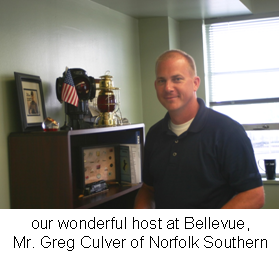 We also saw the engine shop. NS operates large shops at Roanoke and Chattanooga; Bellevue is next in size. They
have five tracks in the shop with one set aside for electrical trouble shooting, one for heavy mechanical repairs,
and one for routine maintenance. They also have a drop table to facilitate traction motor replacement, and a wheel
truing machine. On average they service 44 locomotives a day, nearly half of which get fully serviced. They typically
use 1.5 million gallons of fuel and 250 tons of sand a month to service their equipment. Good safety and housekeeping
practices were much in evidence.
We also saw the engine shop. NS operates large shops at Roanoke and Chattanooga; Bellevue is next in size. They
have five tracks in the shop with one set aside for electrical trouble shooting, one for heavy mechanical repairs,
and one for routine maintenance. They also have a drop table to facilitate traction motor replacement, and a wheel
truing machine. On average they service 44 locomotives a day, nearly half of which get fully serviced. They typically
use 1.5 million gallons of fuel and 250 tons of sand a month to service their equipment. Good safety and housekeeping
practices were much in evidence.
